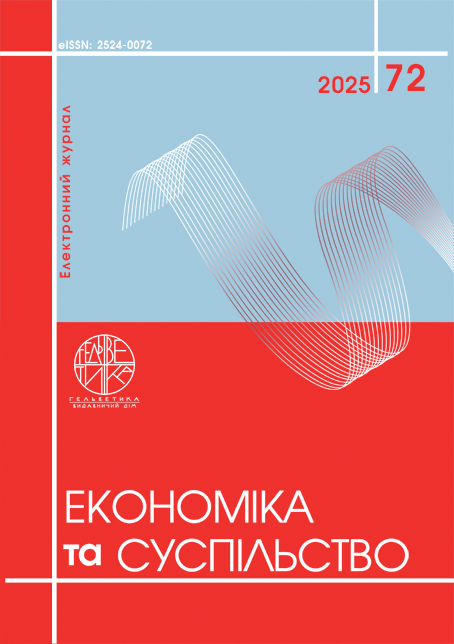STRATEGIC POSITIONING INSTRUMENTS FOR HIGHER EDUCATION SYSTEM SUBJECTS WITHIN INDUSTRIAL INTEGRATION CONDITIONS
Abstract
The goal of the article is to present methodological approaches to the strategic positioning of higher education institutions in the context of transformation of their role and interaction with the industrial sector. The article highlights how modern higher education institutions go beyond the traditional educational function, expanding their activities in the field of research and cooperation with industry, which creates the demands for new tools for their classification and strategic positioning. The article then assesses the limitations of contemporary approaches to the typology of higher education institutions in the context of their increasing industrial integration. A two-dimensional matrix of educational-industrial influence is proposed, which allows classifying subjects within the higher education system according to two key dimensions: educational and industrial influence. A positioning assessment methodology based on the percentile ranking according to metrics in two dimensions is presented. The features of the methodology are flexibility in the choice of indicators, the absence of subjective assessments and weighting factors, as well as the presence of a mechanism for substituting missing data. The proposed methodology was tested on a sample of 103 European higher education institutions using data from The European Higher Education Sector Observatory. The analysis revealed four clusters of institutions with distinct characteristics: institutions with limited educational and industrial impact; research centers with higher industrial but limited educational impact; academically oriented institutions with higher educational but limited industrial impact; comprehensive institutions with a high level of impact in both dimensions. A correlation analysis of indicators of relationships between third-party funding, research and development spending, and doctoral program graduates is also assessed. The proposed instrumentation has practical value for strategic planning, benchmarking, and stakeholder communication. The prospect of further research lies in the development of a system of weighting coefficients based on expert assessments and practical experience of stakeholders.
References
Henry E., Loet L. The Triple Helix—University-Industry-Government Relations: A Laboratory for Knowledge Based Economic Development. EASST Review. 1995. Vol. 14, no. 1. P. 14–19.
Cai Y., Etzkowitz H. Theorizing the Triple Helix model: Past, present, and future. Triple Helix Journal. 2020. P. 1–38. URL: https://doi.org/10.1163/21971927-bja10003 (дата звернення: 09.03.2025).
Lepori B. The heterogeneity of European Higher Education Institutions: a configurational approach. Studies in Higher Education. 2021. P. 1–17. URL: https://doi.org/10.1080/03075079.2021.1968368 (дата звернення: 10.03.2025).
Seeber M., Meoli M., Cattaneo M. How do European higher education institutions internationalize?. Studies in Higher Education. 2018. Vol. 45, no. 1. P. 145–162. URL: https://doi.org/10.1080/03075079.2018.1541449 (дата звернення: 10.03.2025).
Borden V. M. H., McCormick A. C. Accounting for diverse missions: can classification systems contribute to meaningful assessments of institutional performance?. Tertiary Education and Management. 2019. Vol. 26, no. 3. P. 255–264. URL: https://doi.org/10.1007/s11233-019-09045-w (дата звернення: 09.03.2025).
ETER Database. European Higher Education Sector Observatory. URL: https://eter-project.com/data/data-for-download-and-visualisations/database/ (дата звернення: 06.03.2025).
Etzkowitz, H., & Leydesdorff, L. (1995). The Triple Helix—University-Industry-Government Relations: A Laboratory for Knowledge Based Economic Development. EASST Review, 14(1), 14–19.
Cai, Y., & Etzkowitz, H. (2020). Theorizing the Triple Helix model: Past, present, and future. Triple Helix Journal, 189–226. https://doi.org/10.1163/21971927-bja10003 (date of access: 09.03.2025).
Lepori, B. (2022). The heterogeneity of European Higher Education Institutions: A configurational approach. Studies in Higher Education, 47(9), 1827–1843. https://doi.org/10.1080/03075079.2021.1968368 (date of access: 10.03.2025).
Seeber, M., Meoli, M., & Cattaneo, M. (2020). How do European higher education institutions internationalize? Studies in Higher Education, 45(1), 145–162. https://doi.org/10.1080/03075079.2018.1541449 (date of access: 10.03.2025).
Borden, V. M. H., & McCormick, A. C. (2020). Accounting for diverse missions: Can classification systems contribute to meaningful assessments of institutional performance? Tertiary Education and Management, 26(3), 255–264. https://doi.org/10.1007/s11233-019-09045-w (date of access: 09.03.2025).
European Higher Education Sector Observatory. (n.d.). ETER Database [Dataset]. Retrieved March 6, 2025, from https://eter-project.com/data/data-for-download-and-visualisations/database/ (date of access: 06.03.2025)

This work is licensed under a Creative Commons Attribution 4.0 International License.


